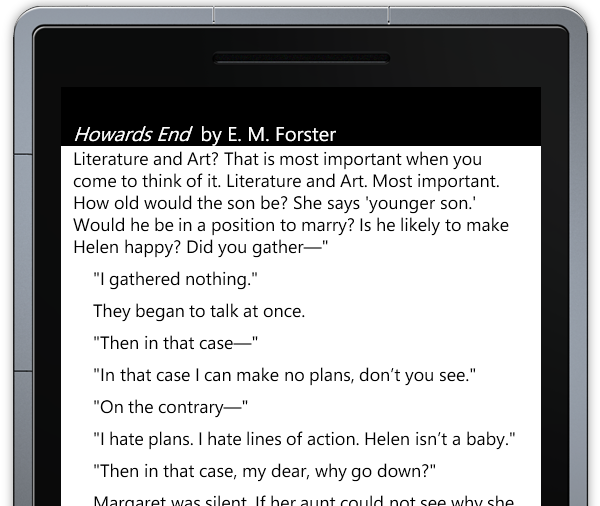Reading Books on the Phone
February 5, 2011
New York, N.Y.
I spend a good chunk of my waking hours staring at a screen. Pretty much all of my work hours are spent that way — typing words into Microsoft Word, or code into Visual Studio, or looking up framework documentation in Internet Explorer — and some of my non-work hours are occupied that way as well, such as with the program I named Blog Hack that I'm using right now.
Even away from the computer, screens are often involved: The TV is an obvious one, of course, but going out to the movies also entails staring at a screen.
More and more these days, I value activities that do not involve a screen. One major non-screen activity for me is reading books and magazines. For over two thousand years, reading did not require looking at a screen, and that's still how I prefer it. If I start reading newspapers, magazines, and books on screens, I'll be spending something like 80 or 90% of my waking hours staring at screens, and that seems way too high to me.
Besides, real books have other advantages as well. From where I sit right now, I can glance over at hundreds of books and pick one off the shelf in an instant. Some of these books I've owned since I was a teenager, and hence are as much a part of my current self as my DNA. Books are complete in themselves. I don't need to worry about my reading device being charged, or if the book is in "the correct format," or if I actually have access to the book if the company who sold me the book no longer exists, or is no longer supporting the device on which I purchased the book.
For these reasons, I haven't been tempted by ebook readers, and I've said so in this blog, even when my attitude sometimes seems to make some people angry and call me a Luddite.
Recently, however, I had the opportunity to use some prototype book-reading software on Windows Phone 7, and I was hooked.

What really seduced me was the sheer convenience of the thing. In my day-to-day excursions out of doors, I travel light. Everything I carry is in my pockets: A wallet, my keys, a couple index cards for notes or brilliant thoughts, a pen, and my phone. Since I'm carrying around the phone anyway, if this phone can also let me read a book, then I'm in heaven.
Whenever I find myself with a minute or two to spare — whether on the subway, or waiting in a checkout line, or sitting in a theater waiting for a concert or movie to begin — I can read a few pages. There's almost no overhead involved. To stop reading, I simply press the on/off button briefly to turn off the screen and put the phone to sleep, and the phone goes back into my pocket. If that's how I left the phone, starting to read again is a snap: Press that button again to wake up the phone, and sweep up the opening screen. The Windows Phone 7 tombstoning activation kicks in, and I'm pack on the page I left at. It all happens very quickly.
If anybody had told me a year ago that I'd be reading books on my phone, I would have been skeptical. After all, it's an awfully tiny screen. The image above of the Windows Phone 7 emulator is more than twice the actual size of the phone itself. (The screen on the HTC HD7 that I'm using these days is about 2 3/16" wide.) However, keep in mind that the Windows Phone 7 screen has an extremely high pixel density. The screen is 480 × 800 pixels so in theory there's plenty of room to display several hundred words of a book page. The resultant image is extremely crisp and very readable.
And I speak as someone who has worn glasses for near-sightedness since about the age of 10, and who has in recent decades also suffered from age-related far-sightedness, and whose right eye is not fully correctable due to an old scar on the cornea. I find the best approach is to prop my glasses on the top of my head, and hold the phone about six inches from my eyes. I think I learned the technique from a well-known phone enthusiast who is two years younger than myself:

Once I get back home, however, I'm back with printed books. This means that I'm reading different books in print and on the phone, but that's not exactly something I think of as a problem.